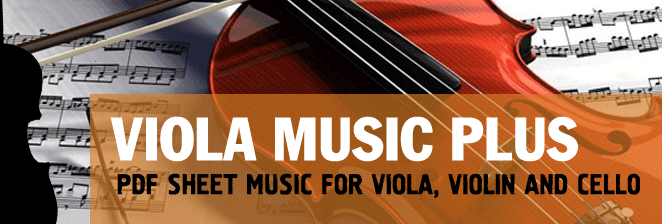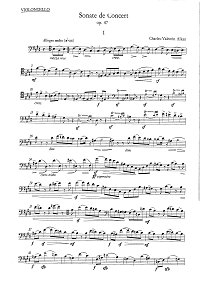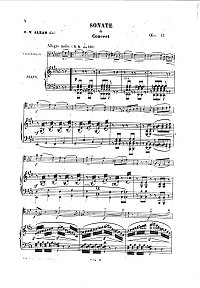|
|
 |
|
| |
| |
Alkan - Cello sonata op.47
|
Concert sonata op.47 for cello and piano E major (1857)
- Allegro molto
- Allegrettino
- Adagio
- Finale alla saltarella. Prestissimo
Alkan - Cello sonata op.47. You can download the PDF sheet music Alkan - Cello sonata op.47 on this page. The splendid Cello Sonata op.47 was written by Alkan in the middle years of the century, reflect a shared ideal of purified expression and a poetic vision of instrumental music. In 1857, at the Salle Erard and with the composer at the piano, Franchomme gave the first performance of the Grande Sonate de Concert op.47 which Alkan had written the year before. This masterly Cello Sonata, a work of the composer's maturity, is a concert piece, as opposed to the 'style brillant' of salon music. Its symphonic dimensions place it in the category of concertante chamber music. The third and last surviving chamber work of the composer, the sonata was published in 1857 with a dedication to James Odier, a rich amateur in whose house the artist played chamber music.
To download PDF, click the "Download PDF" button below the appropriate sheet music image.
To view the first page of Alkan - Cello sonata op.47 click the music sheet image.
|
| PDF format sheet music |
|
|
|
Instrument part: 19 pages. 2043 K
|
Piano part: 63 pages. 4933 K
|
 |
 |
|
|
| Download PDF (14.99
€) |
Download PDF (14.99
€) |
|
The splendid Cello Sonata op.47 was written by Alkan in the middle years of the century, reflect a shared ideal of purified expression and a poetic vision of instrumental music. In 1857, at the Salle Erard and with the composer at the piano, Franchomme gave the first performance of the Grande Sonate de Concert op.47 which Alkan had written the year before. This masterly Cello Sonata, a work of the composer's maturity, is a concert piece, as opposed to the 'style brillant' of salon music. Its symphonic dimensions place it in the category of concertante chamber music. The third and last surviving chamber work of the composer, the sonata was published in 1857 with a dedication to James Odier, a rich amateur in whose house the artist played chamber music.
The expressive climate of the first movement - a vast sonata form structure -links it with the sound world of César Franck. A moving and heroic melos underlies this densely and brilliantly written 'Grande Pièce' (it is worth noting that Franck's Grande Pièce for organ of 1862 was dedicated to Alkan). The intense energy deployed in the nine sections of the central development comes close to the acute complexity of Franck's Piano Quintet, composed twenty years later. The writing for cello, whose lyrical quality is rarely encountered in the composer's works, results from a symphonic emancipation of the instrument; it is full of trills, double- and triple-stopping, runs and orchestral colours which, as in Beethoven, exploit the instrument's potential over a very wide range.
The gentle ternary rocking movement of the Allegrettino derives its disconcerting effect from the equivocal alternation between the naïve peacefiilness of a genre piece, a pseudo-barcarolle in the style of Mendelssohn rooted on a pedal A flat, and a subtle art of transformation which, through circles of modulation, ends up by dissolving the initial pattern. The successive references to this rocking theme, passing through a variety of tonal colours, major, minor, and modal (evoking the tonal palette of Fauré), move little by little to a mood of melancholy: they take the form of recollections, decorative in the piano part, more cantabile in character on the cello. The final section restates the initial motif of the work on the cello, and the sonata's time-scale is concentrated in Romantic fashion around this thematic reminiscence. This movement, a characteristic example of Alkan's poetics, shot through with pathos-laden modulating inflexions, is consummated in a volatile final leggierissimo'. The biblical quotation placed at the head of the Adagio, 'As a dew from the Lord, as the showers upon the grass, that tarrieth not for man, nor waiteth for the sons of men' (Micah V, 7), gives the composition the terms of reference of a place sacred in its essence. This contemplative prayer, the philosophical keystone of the work, is built on the alternation between broad parlando declamation on the cello and a cantabile movement, translucent in its sweetness, which is among the most delicate sonorities the composer ever invented. The build-up of diverse introductory elements, the immobility of the musical fabric consisting of a chimerical trill marked 'legatissimo', and the blurred rhythmic bases of the movement prefigure the rarefied atmosphere of Debussy's piano music.
In contrast to this mystic poetry, the prodigious energy generated by the Finale alia saltarella refutes all the usual clichés about Alkan's hermit-like misanthropy. This bravura movement, conceived during the pianist's long exile from public appearances under the Second Empire, was also published as a piano duet. The almost unplayable tempo that Alkan requires for this final rondo (minim = 112) is another instance of his sarcastic indifference to material contingencies, which already reduced the barcarolle of the second movement to silence earlier in the work. Here, the basic model of the dance (obviously recalling the spirited finale of the 'Kreutzer' Sonata), subjected to an implacable ostinato of almost 300 bars, attains the heights of the pure fantastic - a fonn of 'transcendental study for cello'. |
|
|
|
|
| |
|
|
| |
|
|
|
|